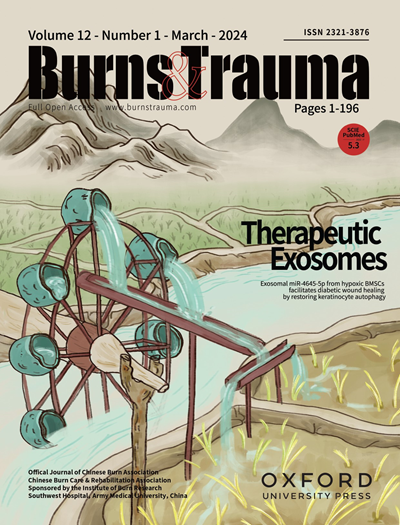单细胞解读瘙痒性瘢痕疙瘩:成纤维细胞和雪旺细胞通过Midkine信号传导的相互作用
IF 9.6
1区 医学
Q1 DERMATOLOGY
引用次数: 0
摘要
瘢痕疙瘩是一种常见的皮肤纤维增生性疾病,可导致严重的美学和功能问题。瘙痒和疼痛是瘢痕疙瘩最常见的临床表现。瘢痕疙瘩内的雪旺细胞(SCs)变异和神经病变导致这些不舒服的感觉;然而,其潜在机制尚不清楚。目的探讨成纤维细胞(FBs)和SCs在瘙痒性和疼痛性瘢痕疙瘩中的潜在作用。方法采用瘢痕疙瘩单细胞RNA测序(scRNA-seq)方法研究瘢痕疙瘩FBs和SCs的活性。这些生物信息学分析结果通过体外细胞培养、临床样本和体内实验得到验证。选定的分子被证实与疼痛和瘙痒相关,随后被用于治疗细胞,以研究其在瘢痕疙瘩中的作用。进行体内抑制试验以评估其治疗潜力。结果我们的scRNA-seq分析发现,特定类型的FBs和SCs在瘢痕疙瘩中比例较高,并具有神经发生相关功能。在对这两种细胞类型进行相互作用分析后,我们确定了一个关键分子,Midkine (MDK),它与患者的疼痛和瘙痒水平呈正相关。此外,MDK处理促进了SCs的增殖及其向修复表型的转变,从而导致神经元轴突发生。这种修复SCs的激活促进了神经纤维中P物质的释放,导致瘢痕疙瘩患者出现疼痛和瘙痒的临床症状。靶向MDK有效地减少异常雪旺细胞增殖,随后抑制引发疼痛和瘙痒的神经肽的分泌。结论我们的研究揭示了FBs和SCs在瘢痕疙瘩疼痛和瘙痒发展中的相互作用,为减轻瘢痕疙瘩的痛苦症状提供了一种新的治疗策略。本文章由计算机程序翻译,如有差异,请以英文原文为准。
Single cell deciphering of pruritic keloids: the interaction between fibroblasts and Schwann cells through the Midkine signaling
Background Keloids are a common skin fibroproliferative disease that can result in severe aesthetic and functional concerns. Pruritus and pain are the most prevalent clinical manifestations of keloids. Schwann cells (SCs) variation and neuropathy within keloids contribute to these uncomfortable sensations; however the underlying mechanisms remain unclear. Objectives To explore the potential role of fibroblasts (FBs) and SCs in pruritic and pain keloids. Methods The activity of FBs and SCs was investigated using single-cell RNA sequencing (scRNA-seq) data of keloids. These bioinformatics analysis results were validated through in vitro cell culture, clinical samples, and in vivo experiments. The selected molecule was confirmed to be correlated with pain and itch and was subsequently used to treat cells in order to investigate its role in keloids. The in vivo inhibition assay was performed to evaluate its therapeutic potential. Results Our scRNA-seq analysis identified specific types of FBs and SCs were present in higher proportions in keloids and exhibited neurogenesis-related functions. Upon conducting an interaction analysis of these two cell types, we identified a critical molecule, Midkine (MDK), which is positively correlated with the patients’ pain and itching levels. Besides, MDK treatment facilitated the proliferation of SCs and their transition to a repairing phenotype, resulting in neuronal axonogenesis. This activation of repairing SCs promoted the release of substance P from nerve fibers, leading to clinical symptoms of pain and pruritus in keloid patients. Targeting MDK effectively reduces abnormal Schwann cell proliferation and subsequently inhibits the secretion of neuropeptides that trigger pain and pruritus. Conclusion Our study uncovered the interaction between FBs and SCs in the development of keloidal pain and pruritus, offering a novel therapeutic strategy to alleviate the distressing symptoms of keloids.
求助全文
通过发布文献求助,成功后即可免费获取论文全文。
去求助
来源期刊

Burns & Trauma
医学-皮肤病学
CiteScore
8.40
自引率
9.40%
发文量
186
审稿时长
6 weeks
期刊介绍:
The first open access journal in the field of burns and trauma injury in the Asia-Pacific region, Burns & Trauma publishes the latest developments in basic, clinical and translational research in the field. With a special focus on prevention, clinical treatment and basic research, the journal welcomes submissions in various aspects of biomaterials, tissue engineering, stem cells, critical care, immunobiology, skin transplantation, and the prevention and regeneration of burns and trauma injuries. With an expert Editorial Board and a team of dedicated scientific editors, the journal enjoys a large readership and is supported by Southwest Hospital, which covers authors'' article processing charges.
 求助内容:
求助内容: 应助结果提醒方式:
应助结果提醒方式:


